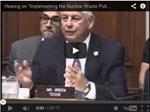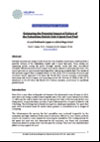Archive for the ‘News’ Category
Sampling detects contamination at WIPP
November 6, 2014
By The Associated Press
CARLSBAD, N.M. (AP) – A pair of air samplers at the nation’s only underground nuclear waste repository detected low levels of radioactive contamination after workers restarted one of the fans at the facility in southeastern New Mexico, officials said Thursday.
They confirmed the contamination was well below levels that would affect the environment or workers at the Waste Isolation Pilot Plant.
"At no time were employees, the public or the environment at risk," the U.S. Department of Energy’s Carlsbad Field Office said in a statement.
The fan, which is part of the underground ventilation and filtration system, was restarted in late October as part of the lengthy process of bringing the plant back online after a canister of waste from Los Alamos National Laboratory leaked inside a storage room.
That radiological release in February contaminated 22 workers and forced closure of the plant.
Officials had expected some residual contamination in the adjacent ductwork and interior workings of the fan since it was running for two months following the incident.
As a precaution, workers took shelter inside buildings before restarting the fan last month and stayed in place for 30 minutes until it was determined to be safe.
Slightly elevated levels of airborne contamination were identified at an air sampler located at the end of the exhaust duct where filtered air exits the underground facility. Contamination was also detected by a second sampler about 60 yards away from the fan.
Officials said the results for the remaining samplers were either below the minimum detectable concentration or within the range normally observed at the site.
The Carlsbad Field Office said it would continue to monitor the air samplers to ensure there are no changes in the readings.
This document contains copyrighted material whose use has not been specifically authorized by the copyright owner. SEED Coalition is making this article available in our efforts to advance understanding of ecological sustainability, human rights, economic democracy and social justice issues. We believe that this constitutes a "fair use" of the copyrighted material as provided for in section 107 of the US Copyright Law. If you wish to use this copyrighted material for purposes of your own that go beyond "fair use", you must obtain permission from the copyright owner.
Loving County to feds: Send us your nuclear waste — and $28 billion
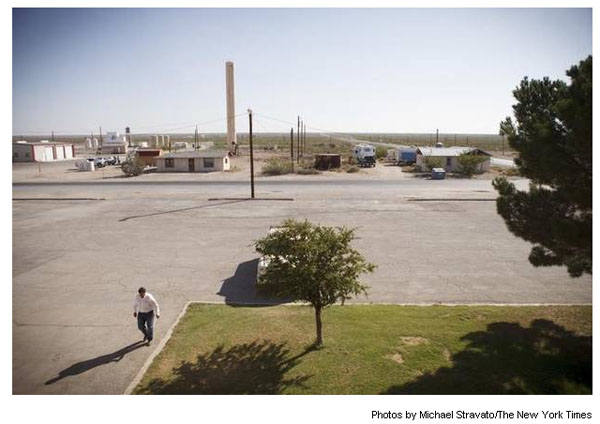
Skeet Jones, a Loving County judge, walks to the courthouse in Mentone. He backs locating a toxic waste storage facility in the county because of the money it would generate.
Published: 07 August 2014 08:01 PM
Updated: 07 August 2014 08:06 PM
Matthew L. Wald,
The New York Times
MENTONE — Loving County is big, dry and stretches for miles, and is the perfect place, local officials say, to store high-level radioactive waste.
Officials here hope to entice the federal government — with $28 billion to spend on the disposal of high-level radioactive waste — into considering the possibility.
"With the money that this would generate for the county, we might even be able to pay the taxpayers back," said the county judge, Skeet Jones. "We could build some roads. We could bring in some more water. We could have a town that’s incorporated, have a city council, maybe even start a school." Loving County had a school, but it has been boarded up for years, and students are bused to neighboring Winkler County.
"Maybe even have a Wal-Mart," Jones mused.
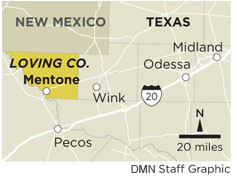 About midway between El Paso and Midland-Odessa, Loving County, population 95, according to the Census Bureau, is spread across 650 square miles. Mentone, the county seat, has a courthouse, a single gas station, a food truck and not much else.
About midway between El Paso and Midland-Odessa, Loving County, population 95, according to the Census Bureau, is spread across 650 square miles. Mentone, the county seat, has a courthouse, a single gas station, a food truck and not much else.
"There are no lawyers, no bank, no hospital, no real estate agency, nothing," said Mozelle Carr, the county clerk. Carr is Jones’ sister.
The family, which makes up about a quarter of the voters in the county, is not unanimous in its support of a storage site. Their father, Elgin R. Jones, who goes by Punk and was sheriff from 1965 to 1992, said he foresaw trouble in anything radioactive. But he admits being in the minority.
The cancellation of the federal government’s plan to bury high-level radioactive waste at Yucca Mountain in Nevada means that the waste will remain at about 70 reactor sites around the country until there is some other plan. Loving County has visions of storing spent fuel from closed reactors in aboveground casks, and later, building a processing plant that would recover unused uranium, and plutonium for reuse, making the rest easier to bury. County officials are working with a company that is hoping to negotiate a deal with the state and federal governments. Two counties just across the state line in New Mexico are also seeking to become storage sites.
Any plan would probably require federal legislation, because the nuclear waste fund is supposed to be used for disposal, not storage. But Congress has an incentive; the Treasury is facing billions of dollars in damage claims because of the Energy Department’s delay.
Storing spent fuel in a central location, in preparation for burial or for reprocessing, looks more attractive as defunct reactors from Maine to California are torn down, and as reactor owners sue the Energy Department, which was supposed to begin accepting the waste for burial in 1998, to recover their costs.
"Interim" storage, though, would mean adding a cumbersome job: shipping the fuel a second time, for burial. Or maybe not. "If we let this waste into Texas, it’s likely never to be shipped anywhere else, because nobody really wants it," said Tom Smith, an energy advocate at Public Citizen in Austin.
Two lawyers in Austin, Monty G. Humble and Bill Jones, raised the idea with Gov. Rick Perry, who Humble said was "not opposed," and then went shopping for a county that would be interested. They argued that two counties in New Mexico, Eddy and Lea, were another possibility, and that if the waste were taken there that the New Mexico counties would get all the benefit but Loving would get some of the risk.
Humble, who specializes in energy topics, and Bill Jones, who was Perry’s first general counsel, formed a company, Advanced Fuel Cycle Initiatives, and have been negotiating with a landowner in the county. The county has designated the two as its agents in Austin, and the two are seeking the same designation from the state of Texas in order to negotiate with the Department of Energy over terms of a lease, including research grants to Texas universities, new roads and emergency equipment for towns in the area.
Perry has ordered a state study of the storage idea. "I believe it is time for Texas to act," he wrote in a letter in March, partly because New Mexico was considering a site within 50 miles of the Texas border.
While some Texas officials oppose the idea of a high-level storage site, some also see it as inevitable. "It’s going to be Texas," said Lon Burnam, a state representative from the Dallas area. "Everyone else is too smart to take it." Burnam fought hard against a low-level waste burial site, which is in Andrews, but was unsuccessful.
In Loving, Raymond Wildman, the cashier at Hopper Station, a gas station and convenience store that is also the county’s only retail outlet, offered another reason that could make a West Texas site attractive. Given the low population, he said, "We wouldn’t be missed if something happened."
This document contains copyrighted material whose use has not been specifically authorized by the copyright owner. SEED Coalition is making this article available in our efforts to advance understanding of ecological sustainability, human rights, economic democracy and social justice issues. We believe that this constitutes a "fair use" of the copyrighted material as provided for in section 107 of the US Copyright Law. If you wish to use this copyrighted material for purposes of your own that go beyond "fair use", you must obtain permission from the copyright owner.
Chicago Hosts U.S.-Canada Energy Summit; Cook County Board Opposes Canadian Nuclear Dump
Oct. 17, 2014
Progress Illinois
Canada’s minister of natural resources is in Chicago this week to talk U.S.-Canada energy policy. Progress Illinois provides highlights from the minister’s keynote address and takes a look at a controversial proposal to build a nuclear waste disposal facility in Canada near Lake Huron’s shore. The Cook County Board passed a resolution last week against the Canadian nuclear dump.
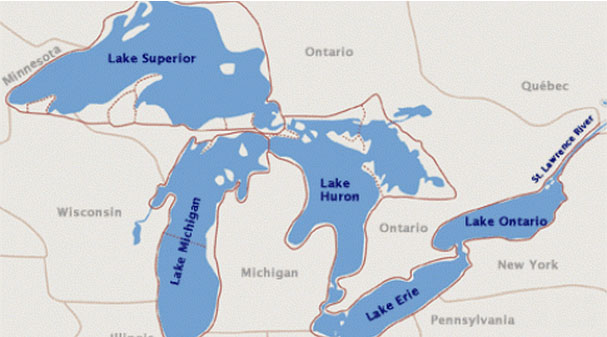
U.S. and Canadian leaders are in Chicago for a two-day summit on the future of energy relations between to the two countries.
The Chicago Council on Global Affairs spearheaded the Thursday and Friday conference with U.S. and Canadian business leaders, policymakers and energy experts. The summit sessions, according to the council, will address how the United States and Canada "can leverage their assets, protect the environment and better align policy efforts."
David Jacobson, former U.S. Ambassador to Canada, delivered brief remarks at the summit Thursday evening ahead of the keynote address from Greg Rickford, Canada’s minister of natural resources.
"We sit literally on the edge of an energy transformation," Jacobson said. "The impact of these changes that are going to take place are going to be extremely widespread, and the world is going to be looking to the United States and to Canada to set the course for our future. It is time that we develop better transnational policies that are going to promote growth in both of our countries."
The U.S.-Canada energy relationship is the largest between any two countries in the world, Jacobson said.
During his keynote remarks, Rickford noted that Canadian crude exports have increased by 63 percent from 2005 to 2013, "with almost all of that product being transported to the United States." Additionally, Canada provides 97 percent of the United State’s natural gas imports and 98 percent of the country’s electricity imports, he said. About half of the energy imported to Canada, meanwhile, comes from the United States.
"We matter to each other," Rickford stressed. "We are each other’s biggest energy customers, with $140 billion in energy trade last year alone … It’s the strength of our relationship that has and will continue to overcome specific projects and challenges and, I would submit respectfully, opportunities moving forward."
"Another key issue here is ensuring our public, in Canada and the United States, that we as countries and in the context of our relationship will continue to share and pursue reducing greenhouse gas emissions," he added.
Canada must also diversify its energy markets beyond the United States, Rickford stressed.
"Our long-standing relationship with the United States has led to a situation in which Canada actually exports 90 percent of its crude oil and 100 percent of its natural gas to one market — the United States," he said. "That’s just too many eggs in one basket. I mean, we love you guys. But market diversification is an imperative for Canada."
By 2035, global energy demand will increase by one-third, he said, and 76 percent of the demand will be met by fossil fuels.
Rickford said Canada "is in the game" and will "meet the burgeoning desire and demand from countries and regions around the world who want to do business with a country that offers political and economic stability." The United States will also "continue to need millions of barrels of oil per day," he said, adding that "Canada can meet this need."
Canada has implemented a "Responsible Resource Development" plan aimed at developing its oil and gas resources responsibly.
"This Responsible Resource Development sets the foundation for Canada to pursue what I think of as three critical elements for energy development: diversifying our energy markets, safeguarding the environment and engaging with communities," Rickford said.
The natural resources minister also mentioned the "elephant in the room" — the controversial Keystone XL pipeline, which he said remains a priority for Canada. The long-proposed pipeline would carry tar sands oil from Canada through the United States to the Gulf Coast of Texas. Rickford said the pipeline, which is widely opposed by environmentalists, should move forward because it is "an important project that would create jobs and economic growth on both sides of the border while increasing North American energy security [and] reducing greenhouse gas emissions."
During questions from the audience, Rickford was asked to comment on concerns surrounding the Keystone pipeline, including environmental impacts.
"The demand is not going to change, and oil sand investments can only improve on what is already a responsible way to develop our resources," he said. "It is not without some issues, but we believe by all accounts and the statistics support that our plan for Responsible Resource Development based on prevention, preparedness, response and liability regimes are an excellent platform from which projects like Keystone … will be heavily scrutinized, and the health and safety of communities is paramount, and these projects simply wont proceed if they don’t meet that test."
Others who are expected to speak at the summit include Pierre Arcand, Quebec’s minister of energy and natural Resources; Admiral Dennis Blair, former U.S. director of national intelligence who co-chairs the Commission on Energy and Geopolitics of the nonpartisan organization Securing America’s Future Energy; Daniel Poneman, the U.S. Department of Energy’s former deputy secretary of energy; and Dawn Farrell, president and CEO of TransAlta Corporation, a power generation and wholesale marketing company.
Canadian Nuclear Waste Site Proposed Near Lake Huron’s Shore
In other Canadian-related news, Ontario Power Generation of Canada is looking to construct an underground disposal facility for radioactive nuclear waste approximately one kilometer inland from Lake Huron’s shore. The proposed nuclear waste burial facility, called a deep geological repository, would be located near the Bruce Nuclear Generating Station in Kincardine, Ontario.
Ontario Power Generation’s plan, which has been under consideration for several years, worries the Cook County Board of Commissioners. The board approved a resolution at its October 8 meeting urging that "neither this proposed nuclear waste repository at the Bruce Nuclear Generating Station site nor any other underground nuclear waste repository be constructed in the Great Lakes basin, in Canada, the United States or any First Nation property."
The Cook County Board joins nearly 140 governmental bodies in the Great Lakes U.S. states and Ontario that have passed resolutions opposing the proposed nuclear waste facility, according to the Canadian citizens group Stop The Great Lakes Nuclear Dump Inc. The city of Waukegan also passed a similar resolution back in February.
"Lake Michigan and Lake Huron are hydrologically connected as one continuous waterbody, and any contamination resulting from a leaking nuclear waste repository located on Lake Huron could affect Lake Michigan’s waters, the source of drinking water for almost 7 million residents of 11 northeastern Illinois counties," reads the Cook County resolution, sponsored by Board President Toni Preckwinkle and Commissioners Joan Patricia Murphy (6th) and Peter Silvestri (9th).
Beverly Fernandez, a Stop The Great Lakes Nuclear Dump spokesperson, applauded the Cook County Board in a statement last week for "showing leadership and taking action to protect this irreplaceable fresh water resource."
"It absolutely defies common sense to bury the most toxic waste humans have ever produced, that remains lethal and dangerous for 100,000 years, approximately 1 kilometer from the drinking water of 40 million people in two countries," Fernandez stressed.
The Stop The Great Lakes Nuclear Dump in late 2012 launched an online petition against the proposed nuclear waste burial facility, which has garnered more than 70,500 signatures.
Federal hearings in Kincardine on the Ontario Power Generation’s proposal wrapped up on September 18. The Canadian federal government is expected to make a decision on the facility in early in 2015.
Lyman Welch, water quality program director at the Alliance for the Great Lakes, said the proposed nuclear waste site is concerning.
"Lake Huron provides drinking water and recreation to millions of people in Michigan and Canada and is a tremendous natural resource, as the Great Lakes are," he told Progress Illinois.
The Alliance for the Great Lakes issued comments to the Canadian federal government opposing Ontario Power Generation’s request for a license for the facility.
"There was no meaningful consideration of alternatives of locations for the project in this process … and that should be done to reach an informed decision on where to locate the nuclear storage facility like this," Welch said. "The siting of a nuclear waste dump on the shore of one of the Great Lakes is a concern for everyone in the region. We have more than 40 million people who rely on the Great Lakes for drinking water and recreation, and we all must be concerned in the entire region when a proposal is put forward without a thorough analysis and alternative."
U.S. Sen. Mark Kirk (R-Illinois) has also joined the call against the project. The Republican lawmaker is one of three co-sponsors of a Senate resolution, introduced last month by Sen. Carl Levin (D-Michigan), calling on the U.S. president and secretary of state to "ensure that the Canadian government does not permanently store nuclear waste in the Great Lakes Basin." U.S. Sens. Tammy Baldwin (D-Wisconsin) and Debbie Stabenow (D-Michigan) co-sponsored the resolution.
An identical resolution was introduced last month in the House by U.S. Rep. Daniel Kildee (D-MI,5). No Illinois House members have co-sponsored that measure.
David Kraft, director of the Nuclear Energy Information Service, a Chicago-based non-profit committed to ending nuclear power, commended the Cook County Board for "its courageous position," but also called attention to other nuclear energy problems.
"Recognizing that placement of a radioactive waste dump on the shores of the drinking water supply for over 40 million people is a bad idea, it can only be a matter of time before public officials acknowledge that 38 nuclear reactors on both sides of the border between the U.S. and Canada creating even more toxic, radioactive and long-lived "high-level" radioactive waste 24/7/365 is not such a good idea, either," he said in a statement.
Image: Canada Alive
This document contains copyrighted material whose use has not been specifically authorized by the copyright owner. SEED Coalition is making this article available in our efforts to advance understanding of ecological sustainability, human rights, economic democracy and social justice issues. We believe that this constitutes a "fair use" of the copyrighted material as provided for in section 107 of the US Copyright Law. If you wish to use this copyrighted material for purposes of your own that go beyond "fair use", you must obtain permission from the copyright owner.
$240 million WIPP recovery plan aims at 2016 reopening
September 30, 2014
By Susan Montoya Bryan
Associated Press via Albuquerque
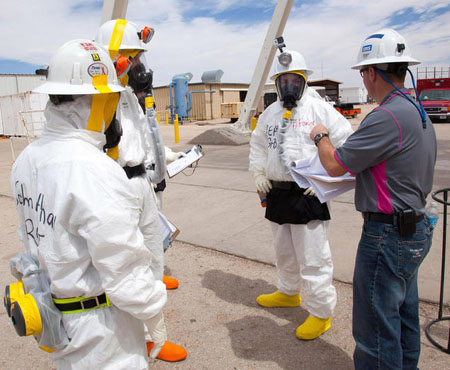
Workers wear protective clothing and positive air respirators April 2 while preparing to re-enter the WIPP underground facility for the first time since the Feb. 14 radiological release. (Courtesy of the Department of Energy)
The U.S. Department of Energy on Tuesday said it’s committed to cleaning up and resuming initial operations at the federal government’s troubled nuclear waste dump in southeastern New Mexico as early as 2016, work that’s expected to cost more than $240?million.
The timeline and cost details were included in a recovery plan developed by the department over several months with help from nuclear industry experts. The plan outlines what needs to be done to decontaminate the underground Waste Isolation Pilot Plant.
Shipments of plutonium-contaminated waste from federal installations around the country have been on hold since early February. That’s when a truck fire and an unrelated release of radiation several days later contaminated 22 workers and forced the closure of the plant.
Mark Whitney, acting assistant secretary for the Department of Energy’s Office of Environmental Management, said officials estimate that 90 percent or more of the nuclear waste dump is free of radiological contamination. But the ventilation system will need to be improved and a new exhaust shaft constructed before full operations can resume, Whitney said. That could take as long as three years and as much as an additional $309?million.
"Once we understand the extent of the contamination, we’ll have a better idea of what our approach to decontaminate will be," he said. "But the report makes clear that the approach we’re looking at right now is not to remove the contamination, but to fix the contamination in place."
One approach will involve spraying water on the half-mile-deep salt walls in which the Waste Isolation Pilot Plant was built. The water will create a crust that will essentially encapsulate the contamination. In areas that might see heavy traffic or the use of large equipment, a type of fixative would be used instead of water.
The department acknowledged Tuesday that investigators have yet to pinpoint what caused the barrel of waste from the Los Alamos National Laboratory to breach Feb. 14 in one of the storage rooms at the nuclear dump. One theory has focused on a chemical reaction in highly acidic waste that was packed with a lead glove and organic cat litter to absorb moisture.
Investigators aren’t expected to issue a final report on the cause until the end of the year.
Initial investigations into both accidents have blamed a slow erosion of safety culture at the site, something Whitney said the recovery plan aims to address.
Watchdog Don Hancock said the plan fails to establish safety standards for the public and for workers as recovery continues. He also questioned the costs of the cleanup and the timeline, given that any regulatory changes would require a public process.
"If there is a serious public and technical discussion about the plan, it’s going to be clear it’s not a plan that anybody in the public, or the regulators, or Congress, or anybody else should have confidence in," Hancock said.
Getting the nuclear dump back on track has been a top priority for the department given that the plant is the government’s only permanent repository for waste such as contaminated gloves, tools and clothing from decades of building nuclear bombs.
However, Whitney told reporters the work to reopen will not be rushed. "We’re not going to be driven by artificial deadlines to resume operations," he said.
The focus, he said, is preparing the nuclear dump to take in the 144 containers of waste that have been stored above ground at the site since the closure. Then, shipments from other sites will be prioritized.
State and federal environmental regulators would have to sign off before operations resume.
Jim Winchester, a spokesman for the New Mexico Environment Department, said it’s too early to comment on the substance of the Department of Energy’s recovery plan. The state agency’s technical staff will review the document, he said.
This document contains copyrighted material whose use has not been specifically authorized by the copyright owner. SEED Coalition is making this article available in our efforts to advance understanding of ecological sustainability, human rights, economic democracy and social justice issues. We believe that this constitutes a "fair use" of the copyrighted material as provided for in section 107 of the US Copyright Law. If you wish to use this copyrighted material for purposes of your own that go beyond "fair use", you must obtain permission from the copyright owner.
Review, relabeling of LANL waste raises questions about scope of problem
September 2, 2014
By Staci Matlock
The New Mexican
As investigators keep trying to pinpoint what caused a drum of radioactive waste from Los Alamos National Laboratory to pop open and leak in an underground repository near Carlsbad, the lab’s review of the incident has led to uncertainty over the volatility of hundreds of other drums, including dozens still at Los Alamos.
The lab notified state environment officials late last month that it was re-evaluating and relabeling as “ignitable” or “corrosive” the contents of 86 drums at LANL.
The drums contain nitrate salts similar to those in the drum that ruptured Feb. 14 at the Waste Isolation Pilot Plant in Southern New Mexico.
The Department of Energy also is reviewing and relabeling more than 300 LANL containers with similar chemicals that are stored in WIPP’s underground salt caverns.
The re-evaluation raises questions about the scope of the problem that led to the leak at WIPP. Lab officials had previously said they believed the problem was isolated to two drums that contained a unique blend of chemicals, causing one of the drums to burst.
The lab’s review of 86 waste drums also prompted state regulators to question whether the lab has authority to “provisionally” relabel those drums as ignitable or corrosive while the contents are analyzed.
Relabeling the drums “does not affect the permanent underground disposal of the waste at WIPP,” said lab spokesman Matt Nerzig. “The drums at Los Alamos are stored safely and securely in robust structures with high efficiency particulate air filtering and fire detection and suppression systems. The drums are visually inspected and monitored for temperature daily.”
Investigators still haven’t determined exactly why a lid on a lab waste container cracked at WIPP, causing the first leak in the waste facility’s 15-year history. But they are looking at possible chemical reactions after kitty litter and neutralizers were added to the drum, which also contained nitrate salts and a lead-laden glove. Some chemists have theorized the added ingredients could have caused waste in the drum to ignite.
Lab staff overseeing waste handling operations at LANL approved the addition of both the kitty litter and the neutralizers by lab contractor EnergySolutions to the drums containing nitrate salt. The lab also approved a switch from a clay litter to a wheat-based litter and agreed to use of a neutralizer that manufacturers warned shouldn’t be mixed with certain chemicals.
Investigators determined a mix of chemicals inside the leaking drum at WIPP generated enough heat to break the container’s lid. But scientists so far haven’t been able to recreate exactly what happened.
The nitrate salt-bearing drums contain waste from Rocky Flats and from the lab’s nuclear research activities. Contents of the waste are listed on waste stream profile forms that help determine how it is repackaged at LANL for storage or shipment.
In July, LANL chemist Nan Sauer told a state legislative committee that the two drums — the one that leaked in WIPP and another one stored at the lab — had a unique set of chemicals.
Still, officials from the lab, the National Nuclear Safety Administration and the Department of Energy decided to review all the nitrate salt-bearing drums. They said their state permits for handling and storing the waste drums require them to recharacterize it when an analysis points to a change in the waste stream.
On July 30, they sent a letter to the New Mexico Environment Department saying they were relabeling the drums as potentially ignitable or corrosive pending further tests and reviews of original waste documents.
New Mexico Environment Department Secretary Ryan Flynn wrote a reply giving the lab until Friday to provide proof the drums may be temporarily relabeled. “NMED is not aware that this approach is supported by regulations or EPA [Environmental Protection Agency] documents,” Flynn wrote.
Flynn also wants the lab to explain why 57 remediated drums of nitrate salt-bearing containers and 29 unremediated ones qualify as ignitable or corrosive under EPA rules. The department also has asked for a list of the unremediated waste drums, how much free liquid is in each one and how the containers will be treated. Remediated drums hold waste that was repackaged with kitty litter and sometimes neutralizer so it will meet requirements for storage at WIPP.
In May, Flynn ordered the lab and the Department of Energy to isolate nitrate salt-bearing containers and to craft a plan for sealing off 368 such containers from the lab currently stored in the WIPP salt caverns.
Meanwhile, WIPP remains closed to new waste shipments and it will cost millions of dollars to get the facility fully operational again.
Contact Staci Matlock at 986-3055 or smatlock@sfnewmexican.com. Follow her on Twitter @stacimatlock.
This document contains copyrighted material whose use has not been specifically authorized by the copyright owner. SEED Coalition is making this article available in our efforts to advance understanding of ecological sustainability, human rights, economic democracy and social justice issues. We believe that this constitutes a "fair use" of the copyrighted material as provided for in section 107 of the US Copyright Law. If you wish to use this copyrighted material for purposes of your own that go beyond "fair use", you must obtain permission from the copyright owner.

